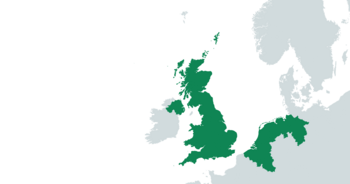Hanoverian Union
Hanoverian Union
| |||||
|---|---|---|---|---|---|
|
Flag | |||||
| Motto: "Eenheid onder de kroon" (Dutch) "Eenheet ënner der Kroun" (Luxembourgish) "Unity under the Crown" | |||||
| Anthem: "The Anthem of Unity" | |||||
 | |||||
| Administrative center | Brussels | ||||
| Official languages | English, Dutch, Luxembourgish | ||||
| Government | |||||
| Alexandra | |||||
• Chairman | Paulette Lenert | ||||
| David Gauke | |||||
| Sigrid Kaag | |||||
| Legislature | Executive Council of the Hanoverian Union | ||||
| Establishment | |||||
| 6 December 1946 | |||||
| Area | |||||
• | 365,754.4 km2 (141,218.6 sq mi) | ||||
| Population | |||||
• 2022 estimate | 106,009,629 | ||||
• Density | 289.8/km2 (750.6/sq mi) | ||||
| GDP (PPP) | 2022 estimate | ||||
• Total | $6.025 trillion | ||||
• Per capita | $56,872 | ||||
| GDP (nominal) | 2022 estimate | ||||
• Total | $5.297 trillion | ||||
• Per capita | $49,967 | ||||
| HDI (2021) | very high | ||||
| Currency | Pound sterling (GBP), Euro (EUR) | ||||
The Hanoverian Union, formerly the Amsterdam-Windsor Union is a politico-economic union consisting of three neighbouring countries in Western Europe, namely the United Kingdom, the Netherlands, and Luxembourg, all three of which are constitutional monarchies with a single Hanoverian monarch as their respective head of state, currently Queen/Grand Duchess Alexandra. Formed in 1946 as a result of the Brussels Agreement between the governments of all three countries, the organisation mainly promotes intergovernmental cooperation between its three member states, with the reigning Hanoverian monarch being promoted and seen as a common and unifying identity between the three countries. With an estimated total population of 105 million, the union covers a total area of approximately 365,754.4 km2 (141,218.6 sq mi), and collectively has an economy worth $5.305 trillion.
The organisation's agenda is mainly decided and enacted by a legislative body, known as the Executive Council of the Hanoverian Union, which is made up of approximately thirty members, with each ten seats being allocated to each of the organisation's three member states, whom would appoint members from their own national legislatures to take up their respective allocated seats. By tradition, the Executive Council convenes every fifteen years, with each session seeing members of the legislative body voting to enact the organisation's seasonal agenda, known as a "Trinational Plan".
Formation
The end of the Second World War in 1945, while not completely so, had inflicted considerable damage to the economies of the United Kingdom, the Netherlands, and Luxembourg, with towns and cities damaged by bombings from both sides, and the lives of civilians lost to enemy gunfire. In response, during the first few post-war years, the British government under Clement Attlee, under the auspices of re-strengthening the personal union between the three countries, first proposed in 1946 the idea of a union between the three countries concerning political and economic matters. Initially, Attlee's proposal was met with some skepticism and lack of enthusiasm from the Dutch and Luxembourgish governments, who were concerned that given the clear difference in economic size between the United Kingdom and their respective countries, the former would therefore automatically become the sole dominating power in the organisation, thereby rendering the Netherlands and Luxembourg's participations useless and ineffective. However, such worries were quickly calmed when, in devising a method for choosing the executive head of the organisation, Attlee proposed that the position should rotate between the three countries after a designated period of time, so as to give each member states an equal opportunity for the leadership spot. Soon enough, the British prime minister's revision on the project was met with satisfaction from the Dutch and Luxembourgish leaders, eventually culminating in the historic Brussels Agreement on 6 December 1946, in which Attlee, together with his Dutch and Luxembourgish counterparts, Louis Beel and Pierre Dupong respectively, unanimously agreed on the final framework of what would later become known as the Hanoverian Union, with the name "Hanoverian" referring to the royal house from which the common monarch of all three countries originated.
